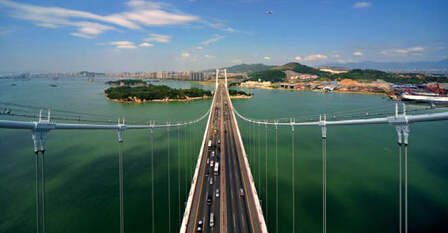

The Xiamen city government will integrate and coordinate land and sea development to fully tap its coastal natural resources, local officials said.
As a modern international port city and one of China's special economic zones, Xiamen enjoys natural beauty, quality development and social harmony, they said.
The city has maintained annual economic growth of about 18 percent over the past 30 years, yet has retained an appealing ecological environment. It has been named an international garden city and won a string of other honors including the UN Habitat Award.
The city government started to focus on ecological conservation and sustainable development at the beginning of the century.
Anticipating President Xi Jinping's call to take full advantage of Xiamen's natural resources and build it into an ecological city, the local government stepped up ecological efforts in 2002.
The city's development model was recognized by Seeking Truth magazine, a Chinese government publication, on the 87th anniversary of the Party's establishment.
Over the past 20 years, the Xiamen government has continued to improve laws covering the marine environment and local nature preserves, as well as water resources and uninhabited island management.
The government has also introduced a range of ecological elements in urban planning.
"Ecological resources are the most valuable of all in Fujian, and the provincial government has put in great effort to build competitive industries based on them," said a government official.
The local government gives a priority to public well-being and strengthened environment and public facility construction.
Since 2004, the city government has earmarked funds to improve the environment upstream on the Jiulong River, the second biggest river in Fujian. It has also contributed 160 million yuan ($26 million) annually to Fujian's environment improvement since 2011, including 80 million yuan for water environment treatment of major rivers.
Other initiatives by local authorities include investment of 1.5 billion yuan to build a 6.76-square-kilometer park in the Xinglinwan area and a 35 km sewage pipeline that can collect 76,900 tons of wastewater daily.
The effort has significantly improved water quality in Xinglinwan, turning it into a waterfront district with harmonious environmental and economic development.
A 12.56 sq km wetland park was also built at the Wuyuanwan area with more than 1 billion yuan spent on wastewater collection, landscaping and de-silting.
In addition, the Xiamen government spent nearly 700 million on treatment of Yundang, Haicang and Tiandi lakes.
In 2011, the government put in extra 560 million yuan to improve Yundang Lake's surrounding shoreline and scenery.
Local authorities have also poured more than 750 million yuan into comprehensive treatment of adjacent sea, removing 85,000 breeding nets and cages, developing 75.3 sq km of mudflats for aquaculture, clearing out 220 million cubic meters of silt and restoring 1.5 sq km of wetland parks.
They have also started protection work on rare sea life to ensure biological diversity.
Xiamen has been named a national advanced city in comprehensive sea management for seven consecutive years and the city's experience has been promoted by the International Maritime Organization.
The city has won awards for outstanding management from the Global Environment Facility, the United Nations Development Program, and the International Maritime Organization.
yangfeiyue@chinadaily.com.cn
 |
| Haicang Bridge is one of the city's landmark structures. Li Luanhan / for China Daily |